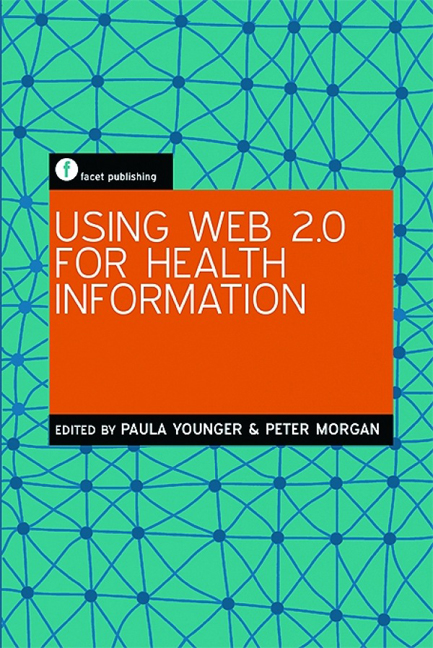Book contents
- Frontmatter
- Contents
- Preface
- Acknowledgements
- Contributors
- Glossary
- Introduction
- Part 1 The basics
- Part 2 Web 2.0 and the implications for health information
- 3 Emerging technologies in health, medical and nursing education
- 4 Supporting learners via Web 2.0
- 5 Supporting research
- 6 Crowdsourcing: the identification of content suitable for the developing world
- 7 Supporting patient needs: an overview of the potential role of Web 2.0 in patient and consumer information
- 8 Some ethical and legal considerations in the use of Web 2.0
- Part 3 Web applications in health information provision: some practical examples
- Part 4 The future
- Index
7 - Supporting patient needs: an overview of the potential role of Web 2.0 in patient and consumer information
from Part 2 - Web 2.0 and the implications for health information
Published online by Cambridge University Press: 08 June 2018
- Frontmatter
- Contents
- Preface
- Acknowledgements
- Contributors
- Glossary
- Introduction
- Part 1 The basics
- Part 2 Web 2.0 and the implications for health information
- 3 Emerging technologies in health, medical and nursing education
- 4 Supporting learners via Web 2.0
- 5 Supporting research
- 6 Crowdsourcing: the identification of content suitable for the developing world
- 7 Supporting patient needs: an overview of the potential role of Web 2.0 in patient and consumer information
- 8 Some ethical and legal considerations in the use of Web 2.0
- Part 3 Web applications in health information provision: some practical examples
- Part 4 The future
- Index
Summary
Introduction
The ultimate aims of healthcare information are to provide information, whether mediated or directly, and to allow patients or health consumers to maintain a good level of health, manage an existing condition or prevent conditions worsening.
Under the NHS Constitution, information provision is now a legal right for patients in the UK. Patients have the right to ‘be given information about [the] proposed treatment in advance, including any significant risks and any alternative treatments which may be available, and the risks involved in doing nothing’. In addition, patients have the right ‘to be involved in discussions and decisions about your healthcare, and to be given information to enable…this’ (Department of Health, 2010).
Web 2.0 would seem to represent a perfect platform for providing patient or consumer information and support for public health in general, offering new, innovative, cost-effective, responsive and timely ways in which to provide that information.
What sources do patients use for information?
In the UK, patients attending their GP surgery (family practitioner) or being discharged from hospital will often be given an information leaflet about their condition which may or may not include details of websites. There are some excellent websites, such as www.patient.co.uk. Many charities also provide a wide range of well researched information, often available for free download from their websites. When medicines are purchased, whether on prescription or over the counter, information leaflets are provided in the packaging.
Some dissatisfaction has been expressed by patients regarding the information they receive from medical and healthcare professionals, nonetheless (Kinnersley et al., 2008). Further, studies suggest that although many patients use health websites that have been put together by government-backed organizations, such as NHS Direct and the BBC, these sites do not necessarily meet their needs (Huntington et al., 2007). In future, however, the way in which patients and health consumers receive their health information may well be through a computer-mediated avatar (Van den Brekel, 2007).
What is of consequence to us as potential mediators of information, then, is the reason why patients would turn to the Web 2.0 realm for health information. Change appears to be taking place in many areas: on the one hand, there is distrust of authority and experts; on the other, an information explosion has been made possible by modern information and communication technologies (Lor and General, 2008).
- Type
- Chapter
- Information
- Using Web 2.0 for Health Information , pp. 79 - 84Publisher: FacetPrint publication year: 2011



